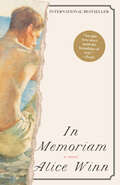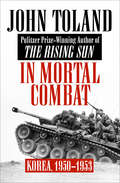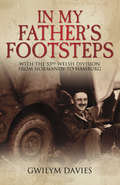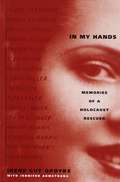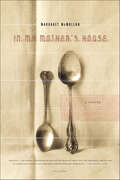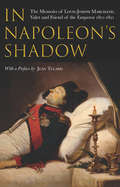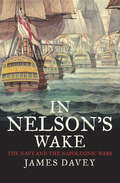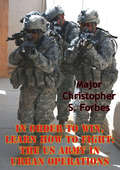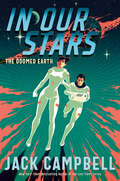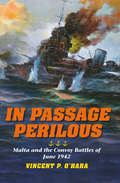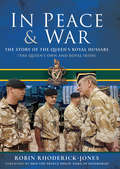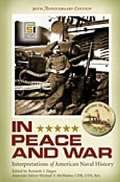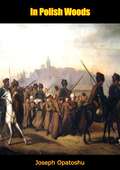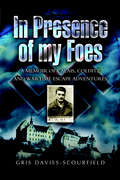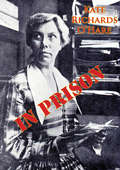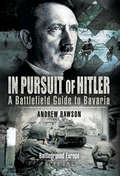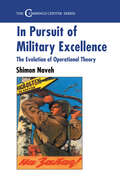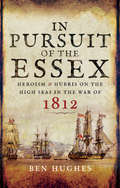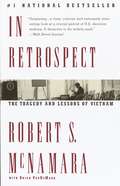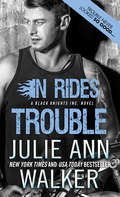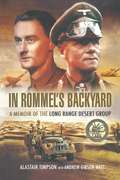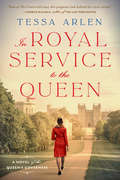- Table View
- List View
In Memoriam: A novel
by Alice WinnGMA BUZZ PICK • INTERNATIONAL BEST SELLER AND AWARD WINNER • A haunting, virtuosic debut novel about two young men who fall in love during World War I • &“Will live in your mind long after you&’ve closed the final pages.&” —Maggie O&’Farrell, best-selling author of Hamnet and The Marriage PortraitA Best Book of the Year: The New Yorker, The Washington Post, NPR &“In Memoriam is the story of a great tragedy, but it is also a moving portrait of young love, and there is often a lightness to the book.&”—The New York TimesIt&’s 1914, and World War I is ceaselessly churning through thousands of young men on both sides of the fight. The violence of the front feels far away to Henry Gaunt, Sidney Ellwood and the rest of their classmates, safely ensconced in their idyllic boarding school in the English countryside. News of the heroic deaths of their friends only makes the war more exciting.Gaunt, half German, is busy fighting his own private battle--an all-consuming infatuation with his best friend, the glamorous, charming Ellwood--without a clue that Ellwood is pining for him in return. When Gaunt's family asks him to enlist to forestall the anti-German sentiment they face, Gaunt does so immediately, relieved to escape his overwhelming feelings for Ellwood. To Gaunt's horror, Ellwood rushes to join him at the front, and the rest of their classmates soon follow. Now death surrounds them in all its grim reality, often inches away, and no one knows who will be next.An epic tale of both the devastating tragedies of war and the forbidden romance that blooms in its grip, In Memoriam is a breathtaking debut.
In Mortal Combat: Korea, 1950–1953
by John TolandA history of the Korean War with soldier&’s-eye views from both sides, by the Pulitzer Prize–winning author of The Rising Sun and Infamy. Pulitzer Prize–winning author John Toland reports on the Korean War in a revolutionary way in this thoroughly researched and riveting book. Toland pored over military archives and was the first person to gain access to previously undisclosed Chinese records, which allowed him to investigate Chairman Mao&’s direct involvement in the conflict. Toland supplements his captivating history with in-depth interviews with more than two hundred American soldiers, as well as North Korean, South Korean, and Chinese combatants, plus dozens of poignant photographs, bringing those who fought to vivid life and honoring the memory of those lost. In Mortal Combat is comprehensive in it discussion of events deemed controversial, such as American brutality against Korean civilians and allegations of American use of biological warfare. Toland tells the dramatic account of the Korean War from start to finish, from the appalling experience of its POWs to Mao&’s prediction of MacArthur&’s Inchon invasion. Toland&’s account of the &“forgotten war&” is a must-read for any history aficionado.
In My Father's Footsteps: With the 53rd Welsh Division from Normandy to Hamburg
by Gwilym DaviesIn 1944-45, Capt. G.H. Davies served with the hard-fighting 53rd Welsh Division. He was an artillery officer in command of a battery of 25-pdr field guns and saw action from Normandy to the final surrender of Nazi Germany. Capt. Davies was present at the Normandy battles, the fierce fighting for s'Hertogenbosch and the Battle of Arnhem.During the course of the war, Capt. Davies kept a diary and also snatched a few photographs on his treasured camera. When the opportunity arose Capt. Davies liberated a camera from a fallen SS officer and, after the war, had the film developed. The film contained graphic images of the war from the German side of the line.Seventy years on from the events, the wartime diary, the photographs of the guns and the photographs taken by the dead SS officer were the inspiration for the son of Capt. Davies, television producer and writer Gwilym Davies, to undertake an emotional return to the battlefields, which his father had described in his diary.The result of that pilgrimage is an important new book which builds upon the wartime diary and the photographs to produce a powerful record of one man's war service with the guns of the 53rd Welsh Division. The book also contrasts the experience of Capt. Davies with those of the Germans on the other side of the line. Gwilym Davies is himself an accomplished photographer and his photographs of the 70th anniversary celebrations and the memorials provide a poignant counterpoint to the events of 1944.
In My Hands: Memories of a Holocaust Rescuer
by Irene Gut Opdyke Jennifer ArmstrongIrene Gut was just seventeen in 1939, when the Germans and the Russians divided and devoured her native Poland. In an instant her life would be transformed--distilled to flight, capture, escape, and hiding. After being rounded up outside of church one Sunday, Irene was put to work for the German Army. Her blond hair, her blue eyes, her youth--these bought her the relatively safe job of kitchen helper and waitress in an officer's dining room. But behind this Aryan mask, Irene began to wage her own war. She picked up snatches of conversation along with the Nazi's dirty dishes and passed the information to Jews in the ghetto. She raided the German Warenhaus for food and blankets. She smuggled Jews from the work camp into the forest. And , when she was made the housekeeper for a Nazi Major, she managed to hide twelve people in the basement of his home and to keep them safe there until the Germans' defeat. Irene Gut Opdyke has received many honors for her actions: Israel's Medal of Honor, recognition from the Vatican, a permanent place in the Holocaust Memorial Museum in Washington, D.C. But this memoir, masterfully written by Jennifer Armstrong, strips away the laudatory titles--Holocaust Rescuer, Righteous Gentile--and reveals the woman herself. Just a girl, really. A girl who saw evil around her and chose to defy it. A girl who proves that the actions of one good person can make a difference; that the will to protect is every bit as powerful as the will to destroy. Ms. Opdyke began to share her story only recently--after hearing the holocaust denounced as a hoax, or propaganda. She now travels the country, speaking about her experiences. Her favorite audience is young people--people who are now the same age she was when the war began. These are the people who are now the same age she was when the war began. These are the people Irene most hopes to empower with the message that each of us can, and must, decide for ourselves what is good and what is evil, and behave accordingly.
In My Mother's House: A Novel
by Margaret McMullanIn My Mother's House is a beautiful, haunting, and elegantly crafted novel about a daughter's obsession to understand her mother's staunch commitment to silence about their family's experiences during World War II Vienna--and how they were able to escape.Told in alternating voices (Elizabeth and her mother Jenny), the story is remarkable for its fullness and rich details: the pieces of family silver the grandmother mails to the family, piece by piece, over the years; Jenny's war-time memories of her uncle's viola d'amore lessons; the fragrant smell of the wood floors at the Hofzeile, the family's longstanding yellow home in Vienna.As Elizabeth begins to fill the gaps of Jenny's troubled memory, she stumbles upon a family secret that ultimately reveals how it is that we inherit the things we do, from one generation to the next.In My Mother's House is a poignant look at a family struggling to regain what took them generations to build and at what cost. It's an emotional, expertly told novel that proves that Margaret McMullan will soon join the ranks of writers such as Anita Shreve and Carol Shields.
In My Wildest Dreams
by Leslie ThomasFrom Barnardo boy to original virgin soldier; from apprentice journalist in London's Fleet Street to famous novelist...At times funny, at times sad, but always honest and utterly compulsive, Leslie Thomas's story is straight out of fiction. As an orphan, he picked his way through the rubble of post-war Britain and was sent on national service to the Far East. Later he became a Fleet Street reporter, with hilarious experiences to relate, and then became the bestselling author of The Virgin Soldiers - the novel that, although scandalous in its day, is now recognised as a classic of its kind. He is also the creator of Dangerous Davies: The Last Detective, which has been adapted into a popular television series. In 2005, Leslie Thomas was awarded an OBE for services to literature.With a new introduction for this edition, this is an amazing story, and Leslie Thomas's magic touch brings it crackling to life with warmth, wit and humour.
In Napoleon's Shadow: The Memoirs of Louis-Joseph Marchand, Valet and Friend of the Emperor, 1811–1821
by Louis-Joseph MarchandIn 1811, twelve young men were chosen among the families in the Emperors personal service to serve as ushers in his apartments. My mother, attached to the household of the King of Rome as first nurse to the prince, requested this favour for me from the grand chamberlain, the Count de Montesquiou, and it was granted.Louis-Joseph Marchands intimate memoir of his time as Napoleons valet is the last of the significant Napoleonic manuscripts to be translated into English and a unique and precious insight into the last days of Napoleons Imperial project.Serving alongside the Emperor from the apex of his reign and through his eventual demise, Marchand depicts, in remarkable detail, the Russian campaign, the campaigns of Germany and France, Napoleons exile to Elba and subsequent escape, his defeat at Waterloo.Friend and confidante to the leader, Marchand was beside him at the Tuileries during the Hundred Days, and he was present to hear Napoleons last words, France my son the army on the island of St Helena.This sincere and authentic testimony from a man with nothing to hide, nothing to apologise for is both a meticulous historical record and a fresh personal perspective on Napoleon.In this work, Tulard remarks in his preface, the Emperor speaks freely. Listen..Marchand presents the somewhat familiar history of the Emperor's decline as completely new territory through conversations, fond stories and personal encounters'.'Marchand's memoirs, republished in English for the first time in two decades, represent a truly irreplaceable contribution to Napoleonic scholarship. Beyond the Emperor as commander and conqueror, Marchand, from his privileged vantage point, illuminates Napoleon the man in rich and absorbing detail.' - John H Gill
In Nelson's Wake: The Navy and the Napoleonic Wars
by James DaveyHoratio Nelson's celebrated victory over the French at the Battle of Trafalgar in 1805 presented Britain with an unprecedented command of the seas. Yet the Royal Navy's role in the struggle against Napoleonic France was far from over. This groundbreaking book asserts that, contrary to the accepted notion that the Battle of Trafalgar essentially completed the Navy's task, the war at sea actually intensified over the next decade, ceasing only with Napoleon's final surrender. In this dramatic account of naval contributions between 1803 and 1815, James Davey offers original and exciting insights into the Napoleonic wars and Britain's maritime history. Encompassing Trafalgar, the Peninsular War, the War of 1812, the final campaign against Napoleon, and many lesser known but likewise crucial moments, the book sheds light on the experiences of individuals high and low, from admiral and captain to sailor and cabin boy. The cast of characters also includes others from across Britain--dockyard workers, politicians, civilians--who made fundamental contributions to the war effort, and in so doing, both saved the nation and shaped Britain's history.
In Order To Win, Learn How To Fight: The US Army In Urban Operations
by Major Christopher S. ForbesThe urgent requirement for US Army preparedness in conducting urban operations (UO) is very real. As global urbanization continues to increase, the contemporary threat environment makes operations in cities impossible to avoid. The past decade has demonstrated through the American experiences in Mogadishu and Russian experiences in Grozny, less capable forces will attempt to use urban terrain asymmetrically to even the balance of power against technologically superior military forces.While we have always had a serious requirement to conduct urban operations, the very nature of the cold war, which was successful by its deterrence, prevented us from ever having to face the reality of fighting such urban engagements. In the post-cold war era, the U.S. Army is forced to face the realities of fighting in the urban environment. It is not enough to speak of preparing for "future urban operations"; the future is here today and the Army must be prepared to engage in urban operations even as it moves towards the objective force. Being prepared means having solid doctrine, realistic training programs and facilities, and appropriate equipment to ensure success on the urban battlefield when the time comes to fight there.
In Our Stars (The Doomed Earth #1)
by Jack CampbellLieutenant Selene Genji has one last chance to save the Earth from destruction in this pulse-pounding science fiction adventure, from the author of the New York Times bestselling Lost Fleet series.Earth, 2180Genetically engineered with partly alien DNA, Lieutenant Selene Genji is different from ordinary humans. And they hate her for it. Still, she&’s spent her life trying to overcome society&’s prejudice by serving in the Unified Fleet while Earth&’s international order collapses into war.Genji is stationed on a ship in orbit when humanity&’s factional extremism on the planet reaches a boiling point, and she witnesses the utter annihilation of Earth. When the massive forces unleashed by Earth&’s death warp space and time to hurl her forty years into the past, Genji is given a chance to try to change the future and save Earth—starting with the alien first contact only she knows will soon occur.Earth, 2140Lieutenant Kayl Owen&’s ship is on a routine patrol when a piece of spacecraft wreckage appears out of nowhere. To his shock, there is a survivor on board: Selene Genji. Once her strange heritage is discovered, though, it becomes clear that Genji is a problem Earth Guard command wants to dispose of—quietly. After learning the horrifying truth, Owen helps her escape and joins her mission.Together, they have a chance to change the fate of an Earth doomed to die in 2180. But altering history could put Genji&’s very existence in danger, and Owen wonders if a world without her is one worth saving. . . .
In Passage Perilous: Malta and the Convoy Battles of June 1942 (Twentieth-Century Battles)
by Vincent P. O'HaraAn invaluable account of one of the most overlooked sea battles of World War II. By mid-1942 the Allies were losing the Mediterranean war: Malta was isolated and its civilian population faced starvation. In June 1942 the British Royal Navy made a stupendous effort to break the Axis stranglehold. The British dispatched armed convoys from Gibraltar and Egypt toward Malta. In a complex battle lasting more than a week, Italian and German forces defeated Operation Vigorous, the larger eastern effort, and ravaged the western convoy, Operation Harpoon, in a series of air, submarine, and surface attacks culminating in the Battle of Pantelleria. Just two of seventeen merchant ships that set out for Malta reached their destination. In Passage Perilous presents a detailed description of the operations and assesses the actual impact Malta had on the fight to deny supplies to Rommel&’s army in North Africa. The book&’s discussion of the battle&’s operational aspects highlights the complex relationships between air and naval power and the influence of geography on littoral operations. &“An important and highly recommended addition to the literature on World War II in the Mediterranean.&” —IPP Naval Maritime History
In Peace & War: The Story of The Queen's Royal Hussars (The Queen's Own and Royal Irish)
by Robin Rhoderick-JonesA British military veteran presents an insider&’s history of the UK&’s elite armored regiment across three centuries of service—&“highly recommended&” (Military Historical Society). Formed in 1993, the Queen&’s Royal Hussars trace their origins back to 1685 when King James II formed a standing army. An amalgamation of two former regiments—the Queen&’s Own Hussars and the Queen&’s Royal Irish Hussars—the QRH carry on the distinguished history of their antecedents. A veteran of both the Queen&’s Own and the Queen&’s Royal Irish, Robin Rhoderick-Jones tells the history of these celebrated regiments who fought alongside each other at Dettingen, Balaklava, the Peninsula, in India and during the two World Wars. Recently the QRH have seen action in Bosnia-Herzegovina, Kosovo, Iraq and Afghanistan where they provided the first cavalry-led ground-holding battlegroup. In Peace and War is a superbly researched record of the QRH through more than 300 years&’ distinguished service to the Crown. While the demands facing the QRH have changed over the years, their dedication, bravery, commitment and sense of humor remain constant.
In Peace and War: Interpretations of American Naval History
by Kenneth J. Hagan Michael T. McmasterThe American version of naval history adds a certain trajectory that does not run straight from a few gunboats to glory but runs parallel to the winding path to power of the country itself. This edition of the 1978 classic reflects that path, and includes newly-created works that provide new insights into what we now know about the early and mid-twentieth century, the Cold War and recent strategy. Both classic and new works cover the navies of the American Revolution, the role of the Navy in the War of 1812, the commercial value of the 1815-1844 Navy and its work, for the Union and the Confederacy, the Navy of growing international power, its participation in the great wars, and its course through diplomacy as one century became another. This is accessible enough to serve as a course reader as well as a reference. Annotation ©2008 Book News, Inc. , Portland, OR (booknews. com)
In Pharaoh's Army: Memories of the Lost War
by Tobias WolffWhether he is evoking the blind carnage of the Tet offensive, the theatrics of his fellow Americans, or the unraveling of his own illusions, Wolff brings to this work the same uncanny eye for detail, pitiless candor and mordant wit that made "This Boy's Life" a modern classic.
In Polish Woods
by Joseph Opatoshu Isaac GoldbergIn Polish Woods, which was first published in its English translation from its original Yiddish in 1938, is a historical novel describing the devolution of the Kotzker dynasty between the age of Napoleon and the Polish Revolt of 1863.Author Joseph Opatoshu reflects on the conflicting and even opposite tendencies in development of the Jewish ideology during this era, which would largely determine the future of the Jewish people: Hasidism, enlightenment, and assimilation.A thoroughly engaging read.
In Presence of My Foes: A Memoir Calais, Colditz, and Wartime Escape Adventures
by Gris Davies-ScourfieldThis is a wartime escape memoir that ranks with the finest. Seriously wounded and captured at Calais, the Author recovered to escape from his POW camp in a load of rubbish. He was on the run thanks to the Polish Underground for nine months and was recaptured within sight of the Swiss border. Interrogation by the Gestapo failed to break him—his greatest fear was that he would betray his friends. Sent to Colditz he again escaped only to be recaptured, due to a minor misspelling on his documents.
In Prison
by Kate Richards O’hareA fascinating view of prisons in the early years of the Twentieth Century.Carrie Katherine "Kate" Richards was born March 26, 1876 in Ottawa County, Kansas. Her father, Andrew Richards (c. 1846-1916), was the son of slave-owners who had come to hate the institution, enlisting as a bugler and drummer boy in the Union Army at the outbreak of the American Civil War in 1861. Following conclusion of the war he had married his childhood sweetheart and moved to the western Kansas frontier, where his wife Lucy and he had brought up Kate and her four siblings, raising the children as socialists from an early age.After America's entry into World War I in 1917, O'Hare led the Socialist Party's Committee on War and Militarism. For giving an anti-war speech in Bowman, North Dakota, O'Hare was arrested and taken to prison by federal authorities for violating the Espionage Act of 1917, an act criminalizing interference with recruitment and enlistment of military personnel. With no federal penitentiaries for women existing at the time, she was delivered to Missouri State Penitentiary on a five-year sentence in 1919. While in prison Richards published two books, Kate O'Hare's Prison Letters (1919) and In Prison (1923). After a nationwide campaign President Calvin Coolidge commuted her sentence. Richards took a keen interest in prison reform and carried out a national survey of prison labor (1924-26).
In Pursuit of Hitler: A Battlefield Guide to the Seventh (US) Army Drive (Battleground Europe)
by Andrew RawsonThis book is a chronology of the Rise and Fall of the Third Reich and the famous victory drive of the Seventh Army. It starts at the Worms Rhine bridgehead and moves quickly onto Aschaffenburg, before describing the Hammelburg Raid to release US POWs. The seizure of Nuremberg was hugely symbolic and this beautiful city was the scene both of the infamous Nazi Rallies and of course the War Crimes Tribunals. The road to Munich, always worth visiting (bierfest or no bierfest!) is via the Danube crossings and the book takes in the liberation of the appalling Dachau Concentration Camp and the battle at the SS Barracks. Munich was the center of Hitlers early life and represented his power base. He was imprisoned here and wrote Mein Kampf. The book climaxes with the approach to the Alps and the superb Eagles Nest, so popular with tourists.
In Pursuit of Military Excellence: The Evolution of Operational Theory (Cummings Center Series #Vol. 7)
by Shimon NavehThis book offers a scientific interpretation of the field of military knowledge situated between strategy and tactics, better known as operational art', and traces the evolution of operational awareness and its culmination in a full-fledged theory. The author, a Brigadier General (ret.) in the Israeli Defence Forces and Doctor of History, King's College, London, clarifies the substance of operational art' and constructs a cognitive framework for its critical analysis. He chronicles the stages in the evolution of operational theory from the emergence of 19th-century military thought to Blitzkrieg. For the first time the Soviet theories of Deep Operations' and Strike Manoeuvre' that emerged in the 1920s and 1930 are discussed. The author argues that it is these doctrines that eventually led to the crystallization of the American Airland Battle theory, successfully implemented in the Gulf War.
In Pursuit of the Essex: Heroism and Hubris on the High Seas in the War of 1812
by Ben HughesOn 26 October 1812, during the war between Britain and the United States, the frigate USS Essex set sail on the most remarkable voyage in the early history of the US navy. After rounding Cape Horn, she proceeded to systematically destroy the British South Seas whaling fleet. When news reached the Royal Navys South American station at Rio de Janeiro, HMS Phoebe was sent off in pursuit. So began one of the most extraordinary chases in naval history.In Pursuit of the Essex follows the adventures of both hunter and hunted as well as a host of colourful characters that crossed their paths. Traitorous Nantucket whalers, Chilean revolutionaries, British spies, a Peruvian viceroy and bellicose Polynesian islanders all make an appearance. The brilliant yet vainglorious Captain Porter of the Essex, his nemesis Captain James Hillyar of the Phoebe, and two young midshipmen, David Farragut and Allen Gardiner, are the principal narrators. From giant-tortoise turning expeditions on the Galapagos to the perils of rounding Cape Horn, via desperate skirmishes with spear-toting natives on the Marquesas and a defeated duellist bleeding his life out onto black, volcanic sands, the reader is immersed in the fantastical world of the British and American seamen who struggled for supremacy over the worlds oceans in the sunset years of the age of sail. Ben Hughess graphic account is a work of non-fiction, yet reads like a novel, from the opening view of the Essex preparing for her cruise on the Delaware River to the storys bloody denouement in Valparaiso Bay.
In Retrospect: The Tragedy and Lessons of Vietnam
by Robert S. Mcnamara Brian VandemarkOne of the major decision-makers of the Vietnam War tells his story.
In Retrospect: The Tragedy and Lessons of Vietnam
by Robert Mcnamara#1 NATIONAL BESTSELLER. The definitive insider's account of American policy making in Vietnam."Can anyone remember a public official with the courage to confess error and explain where he and his country went wrong? This is what Robert McNamara does in this brave, honest, honorable, and altogether compelling book."—Arthur Schlesinger, Jr.Written twenty years after the end of the Vietnam War, former Secretary of Defense Robert McNamara's controversial memoir answers the lingering questions that surround this disastrous episode in American history.With unprecedented candor and drawing on a wealth of newly declassified documents, McNamara reveals the fatal misassumptions behind our involvement in Vietnam. Keenly observed and dramatically written, In Retrospect possesses the urgency and poignancy that mark the very best histories—and the unsparing candor that is the trademark of the greatest personal memoirs.Includes a preface written by McNamara for the paperback edition.
In Rides Trouble (Black Knights Inc. #2)
by Julie Ann WalkerA New York Times and USA Today Bestseller!"Deft characterization, skillful pacing, touches of humor, and red-hot love scenes rev up this highly recommended roller-coaster." —Publishers Weekly Starred ReviewRebel with a CauseBecky "Rebel" Reichert never actually goes looking for trouble. It just has a tendency to find her. Like the day Frank Knight showed up at her door, wanting to use her motorcycle shop as a cover for his elite special ops team. But Becky prides herself on being able to hang with the big boys-she can weld, drive, and shoot just as well as any of them.Man with a MissionMunitions, missiles, and mayhem are Frank's way of life. The last thing the ex-SEAL wants is for one brash blonde to come within fifty feet of anything that goes boom. Yet it's just his rotten luck when she ends up in a hostage situation at sea. Come hell or high water, he will get her back-whether she says she needs him or not.Black Knights Inc. Series Hell on Wheels (Book 1) In Rides Trouble (Book 2) Rev It Up (Book 3) Thrill Ride (Book 4) Born Wild (Book 5) Hell for Leather (Book 6) Full Throttle (Book 7) Too Hard to Handle (Book 8)Wild Ride (Book 9 — coming April 2017!)Praise for Hell on Wheels:"Edgy, alpha, and downright HOT, the Black Knights Inc. will steal your breath ... and your heart!" —CATHERINE MANN USA Today bestselling author
In Rommel's Backyard: A memoir of the Long Range Desert Group
by Andrew Gibson-Watt Alistair TimpsonThis WWII journal takes readers inside an elite reconnaissance and raiding unit operating behind enemy lines in the North African campaign. As a young man entering the maelstrom of World War II, Alastair Timpson had the good fortune to find his way into the most romantic of special force units, the Long Range Desert Group. In Rommel&’s Backyard describes the various roles of the LRDG, all of which involved great daring and endurance deep behind enemy lines. They were the eyes and ears of the Eighth Army, reporting enemy movement; they destroyed enemy aircraft, supply dumps, and vehicles; and they transported other special forces and agents to their objectives. Timpson kept a meticulous record of all his activities with the LRDG. Only after his death, did his son realize the significance of his father&’s journals. In Rommel&’s Backyard is a personal account of the LRDG that epitomizes the spirit of the entire campaign.
In Royal Service to the Queen: A Novel of the Queen's Governess
by Tessa Arlen&“Engrossing. Fans of The Crown will devour this.&”--Publishers WeeklyThe revealing story of Queen Elizabeth II's beloved governess, Marion Crawford, who spent more than sixteen years of her life in loyal service to the royal family and was later shunned by those she has loved and served. Marion Crawford can remember each of the wonderful years when she was governess to the little Princesses Elizabeth and Margaret Rose: included in their lives, confided in, needed, trusted, and loved. These memories will never dim, ever. In Marion's mind, she will always be their Crawfie. But things become increasingly complicated as the young royals navigate adulthood. It is May 1945 and Princess Elizabeth--the heiress presumptive to the British throne--has fallen in love, and the only member of her family who is happy for her is her governess. No one in the young princess's life thinks that Prince Philip of Greece would be a suitable husband for the future Queen of England. No one that is, except for Marion Crawford. Crawfie wholeheartedly supports Elizabeth in her determination to marry Philip. She too has fallen in love--and has convinced her fiancé, George, that they must wait for Elizabeth and Philip to receive the King's blessing before she can leave her service to the Crown. Over the next two years Crawfie is caught between loyalty to Princess Elizabeth; running the risk of alienating her royal employer, Queen Elizabeth; and losing the man she loves. But as Crawfie prevails to marry George and stands with him in Westminster Abbey on Elizabeth and Philip's wedding day, she is unaware that her troubled relationship with Queen Elizabeth is far from over. And just around the corner is a betrayal that will sever her bond with the royal family forever.
